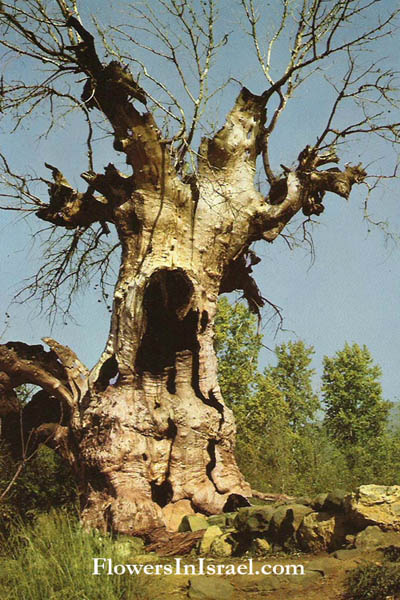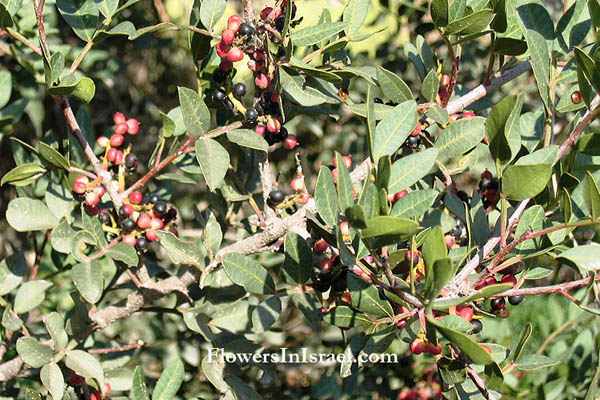Atlantic Pistachio, Terebinth,
Hebrew: אלה אטלנטית, Arabic: بطم أطلسي
| Scientific name: | Pistacia atlantica Desf. | |
| Common name: | Mount Atlas Pistache, Mount Atlas mastic tree, Atlantic Pistachio, Terebinth | |
| Hebrew name: | אלה אטלנטית | |
| Arabic name: | بطم أطلسي | |
| Family: | Anacardiaceae, אלתיים |

|
| Life form: | Phanerophyte, tree | |
| Stems: | Up to 7 m; stout trunk, covered in fissured bark; branches often have galls; drought-tolerant tree, with an extensive root system | |
| Leaves: | Alternate, compound, pinnate; leaves often have galls | |
| Flowers: | Unisexual; pink; flowering occurs before vegetative development, and males tend to flower before females (protandry). Females and males invest more energy in reproduction (that is, seed and fruits) and in flowering early before leaf production | |
| Fruits / pods: | Oblong, fleshy, oily fruit borne by the female tree; 6 to 8 mm long, pink, ripening blue | |
| Flowering Period: | February, March, April | |
| Habitat: | Mediterranean maquis and forest, Hard rock outcrops | |
| Distribution: | Mediterranean Woodlands and Shrublands, Semi-steppe shrublands, Shrub-steppes, Deserts and extreme deserts | |
| Chorotype: | Irano-Turanian | |
| Summer shedding: | Perennating |

Derivation of the botanical name: Pistacia, pistacium (Latin), "pistachio nut", from Greek pistakion, from pistakē, the Greek name for the nut, perhaps from Middle Persian *pistak. "Pistacium" was the basis of Linnaeus' name Pistacia for the genus. atlantica, Atlas Mountains, N.W.Africa. The Hebrew name: אלה, elâh, used for the Pistacia is and like that of the oak, stems from the Hebrew el (God), associated with strenght and sturdiness. The Valley of "Elah", where David went and killed the giant Goliath (I Samuel 17:2-49), received its name from the Pistacia trees growing there. The Hebrew words "êl, "êlâh", and "êlîm", refer to the Pistacia, but, "âllâh", "allôn", and "êlôn" to the Quercus.
In Israel there are 5 species of Pistacia: 1) P. lentiscus; 2) P. atlantica; 3) P. saportae Burnat; 4) P. palaestina; 5) P. khinjuk Stocks. The word for this tree is translated in many different ways. For example, the tree under which King Saul was buried (I Chronicles 10:12) is termed "the great tree" (NIV), "oak" (KJV), and "terebinth" (JND). Of those three terms terebinth is the more correct as one of the species of pistacia. The same tree is called "balsam and "mulberry". Balsem may be used as a name because of a resin extracted from the tree. Several plants are referred to as balsam. Balsem, oak, mulberry and terebinth are not even superficially similar and are unrelated. There are two species of "terebinth" in the Middle East, "the Atlantic pistacia" (Pistacia atlantica) and the "Palestine pistacia" (Pistacia palaestina; Hebrew: elah). The terebinth tree continues to be abundant in the Middle East, growing even in desert areas. The Atlantic Pistacia is the larger one and therefore assumed to be the one referred to in the Scriptures. The trees reach a very large size and can live up to one thousand years. The Atlantic Pistacia is the largest tree in Israel in recent history; a single tree can grow as much as 12 meters high, can yield up to 2 kilograms of resin (turpentine). The terebinth develops a very deep and extensive root system and therefore remains green even in years of drought. It often sprouts from the stump after being cut, as noted in Isaiah (6:13). Because of it's large size and great age, pistacia trees were well-known landmarks and were used as memorials for the dead. A new project to record all sites in which sacred or holy trees are found was begun in 1997 by Rotem. A holy tree is a tree or small group of trees adjacent to prayer or holy burial sites. These trees or groups of trees are usually very large and old and are often connected to the graves of sheikhs. It is estimated that there are approximately 1000 holy trees in Israel. The protection of these sites is important for the cultural heritage of Israel, for environmental protection and for ecological and historical research. Bible resources:
|